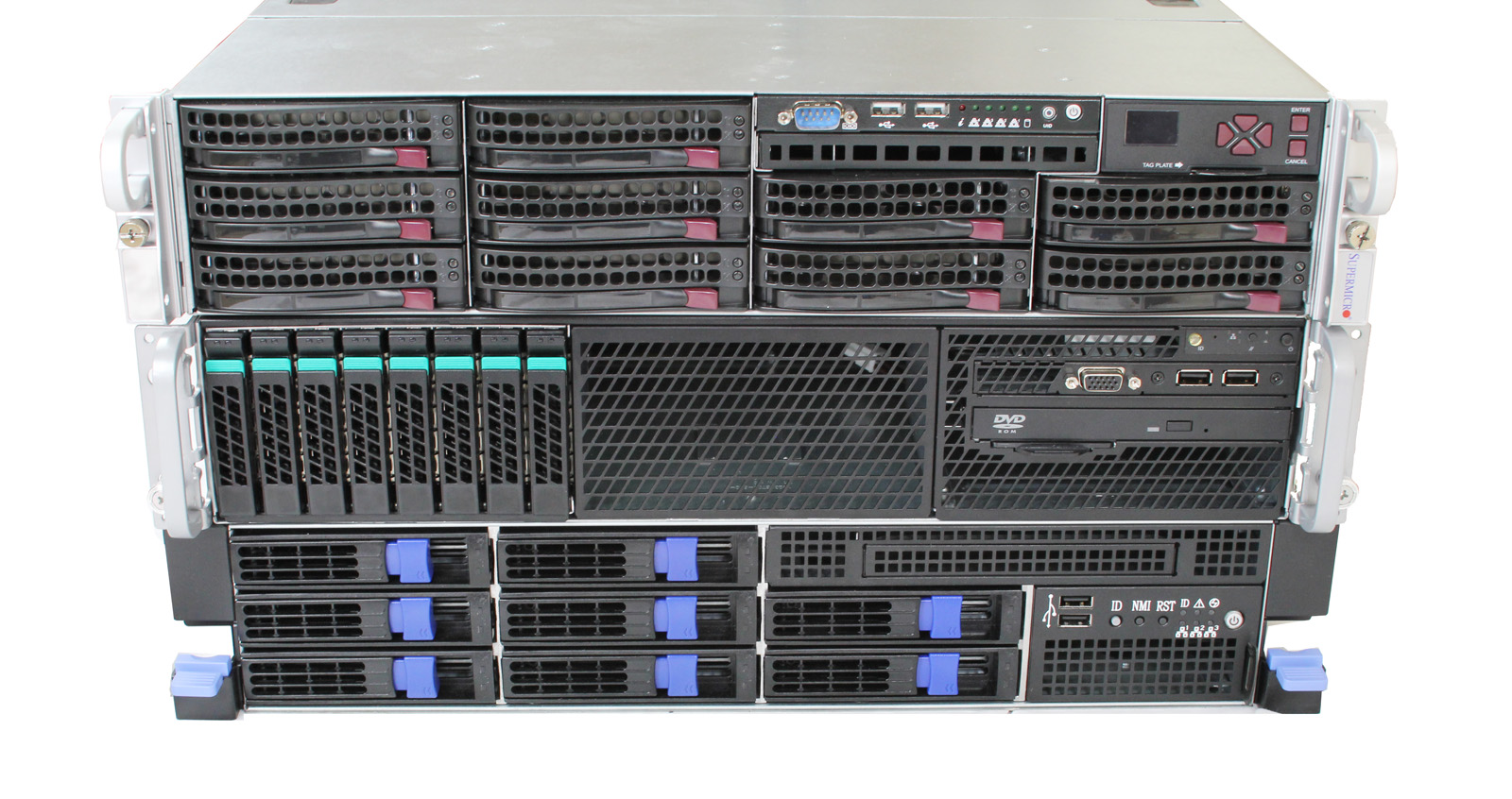Three Xeon E5 Server Systems From Intel, Tyan, And Supermicro
After taking a first look at Intel's Xeon E5 processors, we wanted to round up a handful of dual-socket barebones platforms to see which vendor sells the best match for Sandy Bridge-EP-based chips. Intel, Supermicro, and Tyan are here to represent.
Three 2P Xeon E5-2600 Platforms Compared: Intel, Supermicro, And Tyan
Recently, Chris Angelini wrote about the Xeon E5-2687W CPUs in Intel Xeon E5-2600: Doing Damage With Two Eight-Core CPUs. Chris was able to compare Intel's flagship model, with a 150 W TDP, to the two generations that preceded it, along with a Core i7-3960X on the desktop. Around the same time, we were trying to get our hands on a number of barebones server systems to compare against each other.
We ended up with three very different models from Supermicro, Tyan, and Intel, along with a pair of Xeon E5-2690 processors. The -2960s are the highest-end Sandy Bridge-EP-based chips available for the server market (Chris' -2687Ws are workstation-specific). All three systems occupy 2U of rack space and were designed to accommodate 135 W CPUs, along with tons of memory and several hard drives.
Although much of our attention is spent on enthusiast-oriented desktop hardware and mobile technology, there's unquestionably an allure to a 16-core, 32-thread machine (cooled with passive heat sinks) sporting up to 768 GB of memory, redundant high-efficiency power supplies, hot-swap SAS bays, and all of the other features we associate with higher-end servers. The features found in this space are often precursors to capabilities that trickle down to the desktop, after all.
Two of the three platforms in this round-up employ custom-designed motherboards with accompanying 2U enclosures built to fit them. This type of proprietary design is common in the server segment, and it represents a significant departure from the desktop world where proprietary designs are often shunned by builders in favor of standard form factors and the interoperability benefits they bring. In servers, however, more custom layouts allow vendors to optimize cable routing and cooling, optimize expansion capabilities, and lower power consumption.
Again, the three vendors participating in this round-up are Supermicro, Intel, and Tyan. Gigabyte and Asus were invited as well, but weren't able to provide samples in time for our story. Intel provided two of its newest Xeon E5-2690 CPUs to serve as the test chips in this review. The Xeon E5-2690 is the highest-end non-workstation E5-2600-series CPU Intel sells, and it is rated at a 135 W TDP. Because 2U enclosures do pose thermal challenges, which in turn can impact power consumption, these are ideal test mules for this story. And we wanted to use barebones systems for our evaluation because they function as a foundation for servers, and are meant to be populated with a range of CPUs, memory, storage, and expansion cards.
Today, we're going to be looking at the hardware contained within each platform, along with its remote management capabilities. Although manufacturers don't release exact numbers on the number of systems sold with remote management and KVM-over-IP functionality, informal estimates point to 70% or more of these types of systems including remote management features. It is clearly an important consideration, and something Intel has put emphasis on with its enterprise desktop vPro initiative. Once we look at the systems themselves, we'll have a look at warranty and support options, the relative performance of each system, power consumption, and acoustics.
Get Tom's Hardware's best news and in-depth reviews, straight to your inbox.
Current page: Three 2P Xeon E5-2600 Platforms Compared: Intel, Supermicro, And Tyan
Next Page The Rules, Contenders, And Test Setup-
EzioAs Reply9532821 said:the charts are looking strange. they need to be reduced in size a bit....
I agree. Just reduce it a little bit but don't make it too hard to see -
willard TheBigTrollno comparison needed. intel usually winsUsually? The E5s absolutely crush AMD's best offerings. AMD's top of the line server chips are about equal in performance to Intel's last generation of chips, which are now more than two years old. It's even more lopsided than Sandy Bridge vs. Bulldozer.Reply -
Malovane dogman_1234Cool. Now, can we compare these to Opteron systems?Reply
As an AMD fan, I wish we could. But while Magny-Cours was competitive with the last gen Xeons, AMD doesn't really have anything that stacks up against the E5. In pretty much every workload, E5 dominates the 62xx or the 61xx series by 30-50%. The E5 is even price competitive at this point.
We'll just have to see how Piledriver does.
-
jaquith Hmm...in comparison my vote is the Dell PowerEdge R720 http://www.dell.com/us/business/p/poweredge-r720/pd?oc=bectj3&model_id=poweredge-r720 it's better across the board i.e. no comparison. None of this 'testing' is applicable to these servers.Reply -
lilcinw Finally we have some F@H benches!! Thank you!Reply
Having said that I would suggest you include expected PPD for the given TPF since that is what folders look at when deciding on hardware. Or you could just devote 48 hours from each machine to generate actual results for F@H and donate those points to your F@H team (yes Tom's has a team and visibility is our biggest problem). -
dogman_1234 lilcinwFinally we have some F@H benches!! Thank you!Having said that I would suggest you include expected PPD for the given TPF since that is what folders look at when deciding on hardware. Or you could just devote 48 hours from each machine to generate actual results for F@H and donate those points to your F@H team (yes Tom's has a team and visibility is our biggest problem).The issue is that other tech sites promote their teams. We do not have a promotive site. Even while mentioning F@H, some people do not agree with it or will never want to participate. It is a mentality. However, it is a choice!Reply
